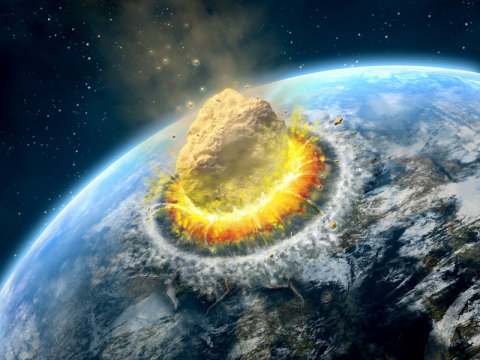[ad_1]
Welcome to the early solar system. Just after the planets formed more than 4.5 billion years ago, our cosmic neighborhood was a chaotic place. Waves of comets, asteroids and even proto-planets streamed toward the inner solar system, with some crashing into Earth on their way.
Now, a team led by University of Colorado Boulder geologist Stephen Mojzsis has laid out a new timeline for this violent period in our planet’s history.
In a study published today, the researchers homed in on a phenomenon called “giant planet migration.” That’s the name for a stage in the evolution of the solar system in which the largest planets, for reasons that are still unclear, began to move away from the sun.
Drawing on records from asteroids and other sources, the group estimated that this solar system-altering event occurred 4.48 billion years ago — much earlier than some scientists had previously proposed.
The findings, Mojzsis said, could provide scientists with valuable clues around when life might have first emerged on Earth.
“We know that giant planet migration must have taken place in order to explain the current orbital structure of the outer solar system,” said Mojzsis, a professor in the Department of Geological Sciences. “But until this study, nobody knew when it happened.”
It’s a debate that, at least in part, comes down to moon rocks collected by Apollo astronauts — many of which seemed to be only 3.9 billion years old, hundreds of millions of years younger than the moon itself.
To explain those ages, some researchers suggested that our moon, and Earth, were slammed by a surge of comets and asteroids around that time. But not everyone agreed with the theory, Mojzsis said.
“It turns out that the part of the moon we landed on is very unusual,” he said. “It is strongly affected by one big impact, the Imbrium Basin, that is about 3.9 billion years old and affects nearly everything we sampled.”
To get around that bias, the researchers decided to compile the ages from an exhaustive database of meteorites that had crash landed on Earth.
“The surfaces of the inner planets have been extensively reworked both by impacts and indigenous events until about 4 billion years ago,” said study coauthor Ramon Brasser of the Earth-Life Science Institute in Tokyo. “The same is not true for the asteroids. Their record goes back much further.”
But those records, the team discovered, only went back to about 4.5 billion years ago.
For the researchers, that presented only one possibility: The solar system must have experienced a major bombardment just before that cut-off date. Very large impacts, Mojzsis said, can melt rocks and variably reset their radioactive ages, a bit like shaking an etch-a-sketch.
Mojzsis explained that this carnage was likely kicked off by the solar system’s giant planets, which researchers believe formed much closer together than they are today. Using computer simulations, however, his group demonstrated that those bodies started to creep toward their present locations about 4.48 billion years ago.
In the process, they scattered the debris in their wake, sending some of it hurtling toward Earth and its then-young moon.
The findings, Mojzsis added, open up a new window for when life may have evolved on Earth. Based on the team’s results, our planet may have been calm enough to support living organisms as early as 4.4 billion years ago.
Other co-authors on the study include Nigel Kelly, formerly of CU Boulder, Oleg Abramov at the Planetary Science Institute and Stephanie Werner at the University of Oslo.
[ad_2]















